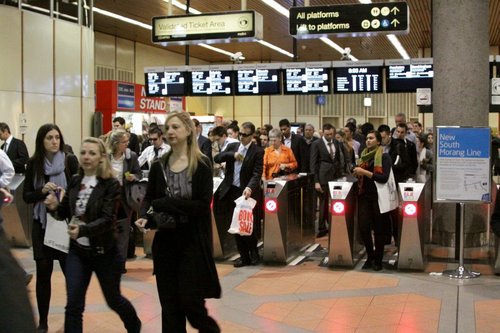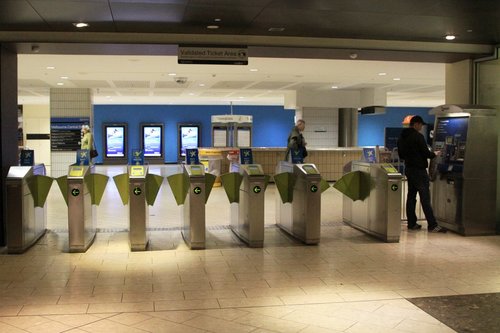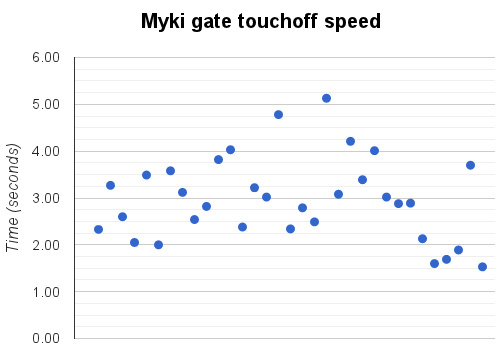How many passengers per minute can a bank of Myki ticket gates process at a Melbourne railway station in morning peak? In the case of Flagstaff Station it doesn’t seem to be enough, and the reason might be the cycle time of the gates – but what about some hard data?
For a ticket gate morning peak at a City Loop station is more intense than afternoon peak: at the start of the day waves of passengers alternate with quiet periods as trains arrive on the platforms every few minutes, but in the afternoon passengers form a steady procession as they arrive on a random basis from their individual workplaces.
So how long does it take a set of ticket gates to allow a single passenger to exist the station? Back in June 2012 I also did some some limited counting of my own at Flagstaff station:
My stopwatch says a successful #myki frankenbarrier touch off takes between 2.27 and 3.66 seconds.
— Marcus Wong (@aussiewongm) July 1, 2012
Wednesday factoid: you can get 20.3 #Myki users a minute through a single Frankenbarrier (assuming no swipers or tappers)
— Marcus Wong (@aussiewongm) June 26, 2012
It resulted in the following unscientific data:
- 21 persons per minute: all using Myki (based upon 7 passengers in 20 seconds)
- 13 passengers in 60 seconds: 1 using Metcard, 12 using Myki, and a Myki user who gave up
So how many passengers through a ticket gate per minute is considered best practice elsewhere in the world? The first source of statistics I found was from the Rail Safety and Standards Board (RSSB) of Great Britain, who write the following in their Rail Industry Standard for Automatic Ticket Gates at Stations document:
For Automatic Ticket Gates (ATGs) already installed a passenger flow rate of 25 passengers per minute for each ATG has been recognised as best practice. This is an average figure which allows for gates not used to the design maximum and takes account of the additional time that new card readers require for the smartcard technology
While the RSSB thinks the use of smartcard readers slows the flow of passengers, issue 14 of the European Public Transport Magazine “Mobility” suggests otherwise:
Oyster has been a phenomenal success for TfL. The system has actually relieved congestion on London’s public transport system, in particular during the morning and evening peak periods. It allows 40 people per minute to pass through ticket gates, 15 more than with magnetic stripe tickets.
Meanwhile in Japan, this article in The Economist suggests their rail operators are even more optimistic about the number of passengers their ticket gates can process:
Many of the keitai-credit systems rely on a NFC chip called FeliCa, which was developed by Sony. This chip is embedded in both NTT DoCoMo’s wallet phones and the new Pasmo system. The chips have to work rapidly and reliably, says Ted Osamura of FeliCa. For instance, the railway operators have insisted that their system can admit 60 passengers a minute through each ticket barrier.
So what are we stuck with back in Melbourne? I eventually found some figures for the Metcard system buried in the infrastructure leases signed in 1999 between the State of Victoria and the private train operators – the section is question was page 2 of this document:
Underground stations were designed to handle crush-loaded trains operating at 2.5 minute headways. Handling capacities have been affected by subsequent commercial development, and barrier deployment (in operational mode 20 persons per minute can be processed by each barrier, suggesting capacities for Melbourne Central of 20,000 passengers/hr, Parliament of 18,000 passengers/hr,and Flagstaff of 9,600 passengers/hr)
With the rollout of Myki almost complete along with the removal of the ‘Frankenbarriers’ from City Loop stations, where are we today?
For more up to date data, the Victorian Rail Industry Operators Group ‘Railway Station Design Standard and Guidelines‘ document comes up with some rather wishful sounding passenger throughput figures:
Gateline length flow capacity shall be based on circulation. Passenger flow rates can be up to 75 passengers per minute based on passengers walking at an average speed of 1m/s, distance between passengers of about 800mm and smart card processing time of 0.8s per smart card.
To determine the real world performance of the new Myki ticket gates, I did some data collection of my own (on a day where the gates were working as normal – not broken down and needing technical assistance):
Cycle time of #Myki barriers at Flagstaff station is somewhere between 1.6 and 3 seconds. (Assuming they aren’t frozen)
— Marcus Wong (@aussiewongm) November 8, 2012
Here is the complete dataset, collected around 8:45am on a weekday morning at Flagstaff Station. I watched a single ticket gate and clicked my stopwatch every time a passenger successfully touched off, only timing when a queue existed, so that I was counting the true minimum cycle time and not counting ’empty’ time between passengers.
With an average touch off time of 2.97 seconds in my dataset, a fraction over 20 passengers per minute can pass through a Myki ticket barrier. I don’t call that an improvement!
Footnote
There is actually a very simple way for passengers to increase the overall flow rate of the ticket gates – the obvious one is making sure they have their ticket ready before approaching the exit!
A second and less known trick is ignore the passenger in front when presenting your Myki to the reader, and instead touching off as soon as the ‘Please present your card’ message reappears on the screen – the gates will cycle closed then reopen after a moment or two, leaving them ready for you to walk through.
Getting the timing right is difficult the first time you try but isn’t impossible – my set of data saw three passengers in a row achieve ~1.6 second touch off times, which equates to a 37.5 passengers per minute flow rate if such skill could be sustained by every passenger.
In the case of the original Metcard gates, a similar process worked – as soon as the ticket validator slot lit up green again, you could pop your Metcard through and the gates would close then reopen, all before you had the change to walk through them. The only exception was the Frankenbarrier: prematurely presenting a Myki to the reader was a recipe for disaster that might leave you with a touched-off card while stuck behind a closed gate.
April 2014 update
The subject of slow Myki gates was brought up again by The Age in April 2014 – Myki to continue beyond contract, says Public Transport Victoria:
Among other lingering myki flaws, the slow response times of myki readers – which leads to long queues at railway stations and delays in the peak hours – is finally being improved, although it may take years for most public transport users to benefit.
Fairfax Media has learned that new, faster gates will be installed at the freshly rebuilt Springvale and Mitcham railway stations next month, with busy Richmond station soon to follow. The new gates, which have eye-catching red paddles, will no longer display fare change or account balance information, only registering whether or not a passenger has successfully touched off.
The new gates can clear 55 people per minute, Public Transport Victoria says, a 20 per cent improvement on the current rate of 45 people per minute.
‘‘These next generation myki gates will be installed progressively across the public transport network as new stations are built or existing stations are upgraded,’’ it says.
Myki never reached its contractually agreed touch-on speeds, but NTT Data will not contribute to the cost of installing the new, speedier gates.
Note how Public Transport Victoria states that the “current” rate is 45 people per minute – that requires sixty passengers in a row to achieve a ~1.3 second touch off time. Time for some more data collection!
Raw data
These figures are ‘near enough’ timed using a stopwatch app on my mobile phone, and are in no particular order. With only 34 data points collected over around 2 minutes at one time of day, one would need to collect a lot more data to do any serious data analysis with it.
| Cycle time (seconds) | ||||
|---|---|---|---|---|
| 3.30 | 2.82 | 5.13 | 1.69 | 3.58 |
| 2.33 | 3.82 | 3.08 | 1.89 | 3.12 |
| 3.27 | 4.03 | 4.21 | 3.70 | 2.34 |
| 2.60 | 2.38 | 3.39 | 1.53 | 2.79 |
| 2.05 | 3.22 | 4.01 | 1.60 | 2.89 |
| 3.49 | 3.02 | 3.02 | 2.49 | 2.13 |
| 2.00 | 4.78 | 2.88 | 2.54 | |




And I remember them adamantly claiming it would take “less than a second”. Lets see what they do with all those stats they collect on passengers.
Quite a joke, isn’t it!
On the subject of data collection, Metcard already allows Metlink / Public Transport Victoria to gather limited travel data, but they still send people out into the field to determine the difference between validations and actual passengers. They also have staff to carry out Origin-Destination (OD) surveys with passengers on trains, trams and buses:
http://ptv.vic.gov.au/assets/PDFs/Annual-Review/Metlink-Annual-Review-2010.pdf
Thats very good work.
Almost as good as the guys at Sydney who have the capability to make their own tickets now.
The few times I have been in downtown Melbourne in rush hour recently, it did seem more crowded than it usually gets in Sydney.
But I think they are dreaming if they think they can rely on getting more than 20 people a minute through the gate. There are too many men and women who walk right up to the gate and stop and then start looking for their handbag.
And even if they get that right, a line of people who have to stop and start every three seconds, cannot be as productive as a line of people who can proceed constantly. People will have to leave larger gaps to avoid bumping into the others, I don’t think 800 mm is enough.
When planes and bridges fall down, the engineers responsible are held up to ridicule but in this case they will get off scot free. It’s not good enough.
Those guys up in Sydney were rather clever – I considered buying a few Metcards for the purposes of decoding the magstripe data, but never had enough time to do the actual analysis.
Great work Marcus!
I don’t know whether or not you have made a trip to Perth to check out our train system over here – but if you get the opportunity, take it!
One thing we’re quite proud of (I work for the Public Transport Authority, who operate the trains) is our SmartRider Card – and how quick and simply it is to use, especially through the barriers.
In the morning peak – unless a card doesn’t work or hasn’t been ‘tagged’ on, most people just flow out of the station through the barriers – barely changing their stride because the reaction time is so quick between hovering the card over the reader (you don’t even need to place the card On the reader!) and the gate opening. It also helps that the SmartRider reader on barriers is on top and flat, which helps a fair bit to keep the flow of passengers going.
When i travel to Melbourne (about once a month when the footy’s on!) i continue to be amazed of how long it takes for a myki to be read at a barrier, and don’t get me started about those frankenbarriers! Like you’ve found they take a long time, and the myki position is in the most inconvenient of places!
I haven’t made the trip to Perth yet, but from what I have read, the response times are as speedy as you say:
http://www.danielbowen.com/2012/07/17/perths-smartrider-vs-myki/
“A second and less known trick is ignore the passenger in front when presenting your Myki to the reader, and instead touching off as soon as the
The reopen then close glitch sounds odd – if it isn’t a regular occurrence perhaps it was just something across the sensors that determine when the paddles open. Otherwise it could just be a software bug, like the one that causes the gates to stop responding completely!
Impressive work, to come up with disappointing figures. Tram readers are so patchy, even allowing for still a good bit of user error.
Nice post Marcus, and well done on getting it into the mainstream media. Keep up the good work.
Looking good Marcus 🙂
http://www.theage.com.au/it-pro/government-it/new-myki-card-readers-no-faster-20121114-29cpu.html
Thanks – it was nice to see it in dead tree edition as well:
Metcard Barriers will take over 45 passengers per minute with metcard and around 20 with Myki. The constraint is the Myki reader, not the Metcard Barrier.
Normal transaction time for any reasonable smartcard is around 300ms. Myki can take up to 5 sec on an FPD
In 2000, Hong Kong gates handled over 75 passengers per minute with their outdated smartcard system developed before 2000.
Myki is the slowest smartcard system in the world.
It’s a pity I didn’t get around to timing how long it took for Metcard users to exit a station in morning peak – by mid 2012 when I started, most commuters had switched to Myki because weekly and monthly Metcards had already been withdrawn.
The 45 passengers per minute figure works out to 1.33 seconds per person – if you got 45 people queued up and with their their tickets at the ready, I can’t see any reason why that rate could not be sustained.
Forget the carbon tax, look how much the worst smartcard ticketing system in the world cost the taxpayer. A complete disgrace.
Comparison to several other countries I have spent significant time in. Maki system is:
Slow to read card
Poor range
Hyper sensitive to other nearby (within wallet or purse)
Poor display of card related information
Card topup systems (both at stations and online) are poorly designed, counter initiative and slow.
One slight positive. The new barriers at stations are an improvement in where the reader is placed .
Overall a very poor solution when compared to many others. Whether the issues are in technologies, design or implementation, it should never have reached production pilot stage.
When you compare Myki to any other smartcard ticketing systems, it is easy to see how much of a dog it is. Given the technology is now maturing overseas, surely the standard for acceptance should have been ‘be at least as good as systems elsewhere’. It doesn’t help that those in charge – the Transport Ticketing Authority – prefer to tell everyone that nothing is wrong and that it will magically get better.
Hehe, your fifteen minutes of fame. You did well on the wireless, even if it sounded like you were talking from the bottom of a biscuit barrel. Before you know it, people will be asking if you are the Minister for Transport.
I’ve put a recording online – I’m going to blame the sound quality on the conference phone at work!
http://soundcloud.com/aussiewongm/my-15-minutes-of-fame
[…] In case you didn’t notice it, yesterday I found my 15 minutes of fame when Tuesday’s blog post on the speed of Myki gates was picked by Melbourne newspaper The Age, and I did an short interview during the Drive show on […]
Look and learn from the Singapore system Melbourne. Put in place since 2001 (yes folks, that was 11 years ago) and works like a charm. Myki is third-world country technology.
Hong Kong’s Octopus card is even older – launched back in 1997, it was the same year Melbourne was still having teething issues with the Metcard system!
Their cards also come in one of two languages – Chinese or English – with the interface of the card readers and ticket machines doing the same:
http://www.checkerboardhill.com/2012/07/hong-kong-octopus-cards-bilingual/
[…] entire point of a smartcard ticketing system is that it is faster than a magnetic strip based one: Myki fails at that. Maybe building the entire system atop Windows CE is the issue, perhaps it is because we hired a […]
Since April 2014 new MYKI gates installed at Richmond and some stations. Main difference is you touch on the screen instead of under it. Oddly, there is still a large pad on the below the screen and people try touching off in the wrong spot all the time Seriously, who designs this stuff?
By the looks of it, the new Vix readers were designed as a drop in replacement for the previous ACS units.
[…] people call it ‘prewalking‘ – and by doing so, you won’t get stuck behind the dimwits who don’t know how to use a myki […]
[…] How fast are Melbourne’s ticket gates? […]
[…] faster than the hybrid Metcard/Myki “frankenbarriers” they replaced. This is based on this great blog post from earlier in the week by Marcus Wong. Well worth a […]